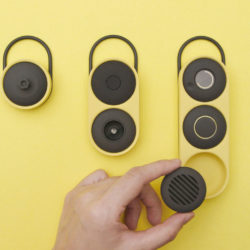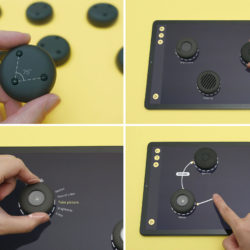Hacko
Description
Inspired by design hacks in our everyday lives - objects that we have consciously redesigned - "Hacko" aims to create a system that allows users to develop their own technical product solutions. "Hacko" is a construction kit consisting of several electronic functional modules. Each disc-shaped module has specific properties. By placing and connecting the modules on the tablet, users can configure functional products for their own purposes. "Hacko" is able to adapt to the changing context by its affordance to be managed and edited anytime. Once a module is broken, it can be replaced individually instead of having to throw away the entire device. When the original configuration is no longer desired, the modules can be reclaimed and reused for another purpose. Ultimately, Hacko's modularity makes technology changeable, updateable, and reusable.What is the Topic?
At a time when technology rapidly develops, electronic devices are often viewed as semi-disposable products that can be easily discarded as soon as the next shiny object comes along. However, when we toss away a gadget, most components inside are rarely past their prime —they are perfectly reusable and deserve a second chance. In fact, most electronic products are drawn from a small pool of functionally similar hardware. Take door intercom, baby monitor, and webcam for example, these three seemingly unrelated devices are actually all made up of camera, speaker and microphone. Nevertheless, most electronics are designed as closed systems and thus exclude the reusability. The objective of this project is to change this cycle by empowering non-skilled users to assemble gadgets from a systematized collection of electronic modules that can be reused across an array of devices.
Why does it look like this?
Interchangeability is one of the main design principles of this project. As a standardised system, the modules share the same disc shape and neutral colour to stay flexible in reconfiguration. At the same time, each module is designed according to its function, that users could distinguish different modules by their look. After being configured on tablet, the modules can be placed into the stand for daily use. The stand is not only a container that integrates several objects, but also a wireless charger for the modules. With the rotatable bracket on the back, the stand is adaptable for different usage contexts —standing, hooking, or hanging.
What is special?
With the electronic modules being freely configured and reconfigured by the user, the outcome of this design was intentionally left open-ended. This offers not only the possibility of reusing electronics, but also the notion of a democratisation in design. Users are empowered to design the end form of the product base on their own need. Instead of being at the receiving end of the design process, users are now included to be part it. So my role as a designer in this project is to “design the design process” instead of “design the design result”. The challenge here is to create the appropriate infrastructure to help users to get the right experience in designing in spite of professionalism. In order to encourage users to take the initiative in designing, it’s important to lower the threshold of designing and programming. Therefore, I simplified the process in both hardware or software aspects.
What is new?
Each module is equipped with a built-in micro-controller working independently, so wiring is no longer required. On the base surface of the modules, there are three raised conductive points forming an isosceles triangle. When a module is placed on the tablet, the capacitive touchscreen can detect what and where that module is by the different vertex angles mapped to different modules. Then, I implant the idea of concept mapping, drawing an arrow from one module to another would define the relationship between them. (Please refer to the video for the interactions in detail.) This way, users are able to embody their ideas intuitively and create a functional electronic device without any coding. If DIY is not desired, there are also many ready-to-use templates available on the app. Users only have to place the corresponding module on the right place on the screen to activate it.




